Improve Cardiorespiratory Fitness with Tai Chi
By John M. de Castro, Ph.D.
“practicing Tai Chi Chuan regularly may delay the decline of cardiorespiratory function in older individuals. In addition, TCC may be prescribed as a suitable aerobic exercise for older adults.” – J.S. Lai
Cardiovascular disease is the number one killer, claiming more lives than all forms of cancer combined. “Heart disease is the leading cause of death for both men and women. About 610,000 people die of heart disease in the United States every year–that’s 1 in every 4 deaths. Every year about 735,000 Americans have a heart attack.” (Centers for Disease Control). A myriad of treatments has been developed for heart disease including a variety of surgical procedures and medications. In addition, lifestyle changes have proved to be effective including quitting smoking, weight reduction, improved diet, physical activity, and reducing stresses. Cardiac rehabilitation programs for patients recovering from a heart attack, emphasize these lifestyle changes. Unfortunately, for a variety of reasons, 60% of cardiac patients decline participation, making these patients at high risk for another attack.
Contemplative practices, such as meditation, tai chi, and yoga, have also been shown to be helpful for heart health. In addition, mindfulness practices have also been shown to be helpful for producing the kinds of other lifestyle changes needed such as smoking cessation, weight reduction and stress reduction. Tai Chi and Qigong are ancient mindfulness practices involving slow prescribed movements. They are gentle and completely safe, can be used with the elderly and sickly, is inexpensive to administer, can be performed in groups or alone, at home or in a facility or even public park, and can be quickly learned. In addition, they can also be practiced in social groups without professional supervision. This can make it fun, improving the likelihood of long-term engagement in the practice. Since Tai Chi is both a mindfulness practice and an exercise, it may be an acceptable and effective treatment for cardiac patients.
In today’s Research News article “The Effect of Tai Chi on Cardiorespiratory Fitness for Coronary Disease Rehabilitation: A Systematic Review and Meta-Analysis.” (See summary below or view the full text of the study at: https://www.ncbi.nlm.nih.gov/pmc/articles/PMC5758591/ ), Yang and colleagues review, summarize and perform a meta-analysis of 5 published studies involving the application of Tai Chi practice for cardiac patients. Two studies were randomized controlled trials while 2 did not have a comparison (control) condition.
They report that the published studies found that Tai Chi practice produced significant improvement in the oxygen carrying capacity of the blood (VO2max) and was superior to light or moderate exercise but not different from intense exercise. Tai Chi practice also produced a significant improvement in peak heart rate in comparison to baseline and no exercise, but was inferior to intense exercise in this regard. Hence, there is evidence that Tai Chi practice can be of benefit to cardiac patients improving cardiorespiratory function.
The studies reviewed tended to have small samples or had week or nonexistent control conditions. So, conclusions must be tempered. The present summary, however, suggest that larger randomized controlled trials are justified. Tai Chi was not found to be as beneficial as intense exercise. But, intense exercise may be dangerous for cardiac patients. The attractiveness of the low intensity, low cost, convenient, and socially fun nature of Tai Chi practice makes it a good choice for cardiac patients.
So, improve cardiorespiratory fitness with Tai Chi.
“The slow and gentle movements of Tai Chi hold promise as an alternative exercise option for patients who decline traditional cardiac rehabilitation.” – Science Daily
CMCS – Center for Mindfulness and Contemplative Studies
This and other Contemplative Studies posts are also available on Google+ https://plus.google.com/106784388191201299496/posts and on Twitter @MindfulResearch
Study Summary
Yang YL, Wang YH, Wang SR, Shi PS, Wang C. The Effect of Tai Chi on Cardiorespiratory Fitness for Coronary Disease Rehabilitation: A Systematic Review and Meta-Analysis. Front Physiol. 2018 Jan 4;8:1091. doi: 10.3389/fphys.2017.01091. eCollection 2017.
Abstract
Background: Tai Chi that originated in China as a martial art is an aerobic exercise with low-to-moderate intensity and may play a role in cardiac rehabilitation. Aim: To systematically review the effect of Tai Chi on cardiorespiratory fitness for coronary disease rehabilitation. Methods: We performed a search for Chinese and English studies in the following databases: PubMed, EMBASE, Cochrane Central Register of Controlled Trials, Chinese Biomedical Literature Database, China Knowledge Resource Integrated Database, Wanfang Data, and China Science and Technology Journal Database. The search strategy included terms relating to or describing Tai Chi and coronary disease, and there were no exclusion criteria for other types of diseases or disorders. Further, bibliographies of the related published systematic reviews were also reviewed. The searches, data extraction, and risk of bias (ROB) assessments were conducted by two independent investigators. Differences were resolved by consensus. RevMan 5.3.0 was used to analyze the study results. We used quantitative synthesis if the included studies were sufficiently homogeneous and performed subgroup analyses for studies with different control groups. To minimize bias in our findings, we used GRADEpro to grade the available evidence. Results: Five studies were enrolled-two randomized controlled trials (RCTs) and three nonrandomized controlled trials (N-RCTs)-that included 291 patients. All patients had coronary disease. ROB assessments showed a relatively high selection and detection bias. Meta-analyses showed that compared to other types of low- or moderate-intensity exercise, Tai Chi could significantly improve VO2max [MD = 4.71, 95% CI (3.58, 5.84), P < 0.00001], but it seemed less effective at improving VO2max as compared to high-intensity exercise. This difference, however, was not statistically significant [MD = -1.10, 95% CI (-2.46, 0.26), P = 0.11]. The GRADEpro showed a low level of the available evidence. Conclusion: Compared to no exercise or other types of exercise with low-to-moderate intensity, Tai Chi seems a good choice for coronary disease rehabilitation in improving cardiorespiratory fitness. However, owing to the poor methodology quality, more clinical trials with large sample size, strict randomization, and clear description about detection and reporting processes are needed to further verify the evidence.









